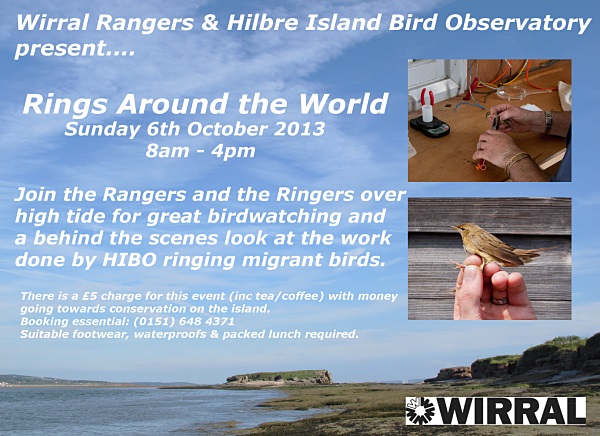Site menu:
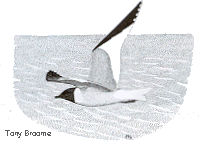
September 2013 Newsletter
The Water Pipit on the Dee Estuary.
Wirral's Wonderful Waders.
Wanted - Voluntary Wardens at Point of Ayr.
August Bird News.
Forthcoming Events.
Latest Newsletter.
Notes on the Water Pipit on the Dee Estuary
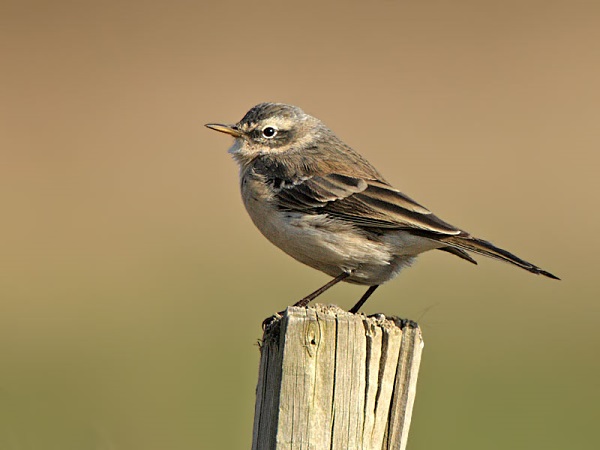
By Ray Eades
Since returning to Wirral in the spring of 2010 after an
absence of
22 years, I have noticed great changes in the bird life of the Dee
estuary. The large flocks of finches which used to winter on
the salt marshes have decreased drastically, whilst other, larger
species, such as Pink-footed Geese and Little Egrets have become
regular.
Along the high water line of the Dee estuary, the Rock Pipit seems to
have become scarcer. Thus, in almost daily morning walks
before the tide along the Parade at Parkgate; I have yet to see a Rock
Pipit Anthus petrosus,
a bird which used to be regular here in
winter. I attribute this to the change of habitat in the
upper salt marshes due to accretion of the estuary. The tide
now reaches the historic tide line so infrequently that the upper salt
marshes seem to be almost fresh water in habitat, the salt being washed
out by rain and fresh water draining from the land.
However, the Rock Pipit is still a regular winter visitor to the true
salt marshes of the Dee. Most winter months when I walk out
to the vantage point off Neston from which to count the waterfowl for
the WeBS count, one or two Rock Pipits are flushed, giving their
distinctive, short strident call. The Cheshire and Wirral
Bird Report details large numbers on high tides at Parkgate, which I
have failed to see so far, but is consistent with the wintering
population on the extensive Dee Marshes given by Norman (2008).
In contrast, a species which, for me, has long retained its elusive
nature is the Water Pipit
Anthus spinoletta. The stream which
runs into the Dee estuary by Neston Sewage Works (the remnants of
Stanney Brook) has long been a favourite Cheshire haunt of this
species. It was first found here “near Parkgate” in 1937 by
H.G. Alexander, and confirmed soon after by A.W. Boyd. The
next Cheshire record was one “in beautiful summer plumage” seen by Boyd
“on the shore of a small mere in South Cheshire” on April 3rd 1939
(Boyd 1946). These records were accepted by Witherby et al
(1942).
The identification of this group of pipits has long been
problematic. Alexander (1974) devoted seven pages to the
story of Water Pipits in Britain. As he pointed out, Saunders
in the standard work of 1899 only allowed six records in Britain, none
in Cheshire. Nicoll (1906) was the first to suggest the then
subspecies was regular on the south coast, and observers between the
Wars discovered Water Pipits in the watercress beds of lowland
England. Watercress beds provided a constant source of water,
often calcareous from aquifers, with a secure supply of invertebrate
food over winter. Coward (1950) in the 7th Edition updated by
Boyd, both esteemed Cheshire ornithologists, flatly stated “Many of the
supposed British Water Pipits were Rock Pipits of the Scandinavian
race” and found the calls of pipits difficult. Norman (2008)
in his definitive and monumental work gave winter records for Neston
Old Quay, Heswall shore and Frodsham Marsh.
In 1960 and 1961 the group of ringers led by Rob Cockbain and Graham
Thomason, which became the Merseyside Ringing Group, caught both Rock
Pipits and Water Pipits at Neston Reed Bed (which was much smaller in
area at that time). In these years the late Eric Hardy led
MNA members to Neston Old Quay to see Water Pipits, and reported
sightings in the local press and MNA reports (Hardy 1962, 1963).
The late Eric Dimelow had an excellent slide taken at Neston Reed Bed
of a Water Pipit and a Rock Pipit in the hand together for comparison
which he used to show at meetings of the Merseyside Ringing Group as an
aid to identification. The striking pale supercilium and
white outer tail feathers made an obvious contrast to the darker
colours of the Rock Pipit. However, at that time Rock and
Water Pipits were ‘lumped’ together as one species, and BTO bird
ringing statistics for the period did not show whether a ringed bird
was identified as a Rock or a Water Pipit.
Coward and Boyd (1900) in the first county avifauna did not mention the
Water Pipit, but described Rock Pipit nesting on Hilbre, whilst Hardy
(1941) gave records for Liverpool sewage works, but no new ones for
Wirral. Bell (1962) page 40 listed Water Pipit as a rarity,
on a par with Richard’s, Tawny and Red-throated Pipits. Yet,
Bell (1967) stated “This subspecies is now regarded as an almost
regular winter visitor to the Dee Marshes” and gave details of these
records.
Crossing the political boundary into Flintshire, Water Pipits were
regular winter birds in the 1970s, as at Shotton Pools in the Reserve
within the Steelworks, where several were ringed, and I have handled
them there myself. However, the habitat matured to wet scrub,
and the species seems to have not been recorded in recent
years. Another possibility at this industrial site is that
the micro climate might have become colder after the 1980 closure of
the blast furnaces when primary steel making finished on site, though
data for this is lacking.
Water Pipits were reported in the CBR, and regularly on local Web sites
at Neston Old Quay and Neston Sewage Works, but I had never seen
one. However, I did come across pipits on the stream, with
white outer tail feathers. Unfortunately, these birds
invariably possessed the pink legs, warmly streaked plumage and weak
calls of Meadow Pipits Anthus
pratensis and I was beginning to lose
faith in ever finding this species. But, on 5th January 2012,
in the afternoon with a cold NW wind blowing and good visibility, a
larger pipit flew along the stream, out onto the marsh and landed on
the edge of the creek, calling with a Rock Pipit type call, and showing
white outer tail feathers.
I returned on 6th January 2012, in the afternoon in overcast
conditions, and got a brief view of the bird on the marsh at 50m range
with my Zeiss 10x 40 bins. It showed white outer tail
feathers and flew off at an attempted nearer approach, calling
stridently, with the shy behaviour noted by Johnson (1970).
On 11th January I got another unsatisfactory view, but noted dark legs,
white throat and slight streaks to flanks without seeing the rectrices.
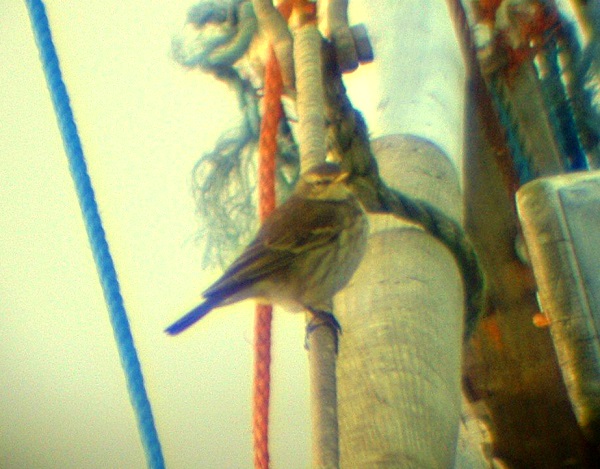
Cold weather, and absence from the Dee
intervened, but on 5th February
2012 I walked along the eastern boundary fence of the Sewage Works,
looking in at the birds feeding actively on the clinker beds.
It was a cold day, temperature 2oC, with bright light. Only
20m away on sprinkler bed No 5, which was not being used, a group of
birds were feeding on the surface and internal side of the retaining
wall and on the clinker surface. They were a Meadow Pipit, a
Pied Wagtail and a third pipit, oblivious to my presence.
This larger pipit was strikingly pale, with a white supercilium, white
throat, darker streaking down its flanks, two obvious pale wing bars
formed by tips to its coverts, and white outer rectrices. Its
call was that of a Rock Pipit to my ears, strident and a single
note. One disconcerting feature was its leg colour, a deep
dark red wine colour, not the blackish which I had expected.
However, on looking in books at home, that colour tone was exactly
shown in Jonsson (1992) page 366. I have no doubt that this
bird was a Water Pipit, and it is my belief that the previous records
were also Water Pipits, though the evidence is weaker.
Similarly, in 2013 on 23rd January in cold weather I again checked the
Sewage Works from outside the fence. No 5 bed was again not
working, and No 4 sprinkler was moving at a reduced speed.
This might have accounted for the presence of a Meadow Pipit, a Pied
Wagtail and once again, a Water Pipit feeding on the clinker
surface. They allowed the sprinkler arm to pass over their
head whilst remaining between the flows of water. The Water
Pipit made a fine sight, and the tips of its two outer tail feathers
were of the purest white, so much so, that I wondered if they were
actually frozen, but close examination showed this colour to be purely
the feathering of the pipit.
It is interesting to speculate on the history of this species on the
Dee. It is my belief that one or two Water Pipits have
wintered here for many years, possibly since the opening of the sewage
works in 1904 (Place 1996) and the growth of the early salt
marsh. The attraction must surely be the mild microclimate,
with a fresh water stream which appears never to freeze, even in the
coldest winter, and the availability of food on the sewage beds during
severe weather. The birds presumably fly here, in a
north-west direction, from some Alpine haunt, and the security of some
invertebrate food supply must outweigh the rigours of this migration
(Lack 1986).
A further mystery might be the role of the small mollusc Assiminea
grayana, which Bourgogne (1994) described as the main food
of
Scandinavian Rock Pipits in salt marshes in The Netherlands.
This mollusc was unknown on the Dee estuary, and indeed the west coast
until recently despite the searches by generations of local
fieldworkers (Kerney 1999). However, in 2006 Assiminea
grayana was reported on the Dee estuary (Willing 2006 et
seq.) part of
a massive range expansion which has taken this mollusc to Morecambe Bay
(Willing 2012). My searches for this small snail have not yet
been successful, but our knowledge of the ecology of these pipits is
still imperfect.
A recent estimate (Musgrove et al. 2013) gives a GB/UK figure of only
190 Water Pipits, so we are fortunate to have them. Quite
possibly, Scandinavian Rock Pipits are also here, together with Grey
and Pied Wagtails. Long may they grace us with their presence
and challenge our identification skills.
Ray Eades
References
Alexander H.G. 1974 Seventy Years of Birdwatching, Poyser Berkhamstead.
Bell H.T. 1962 The Birds of Cheshire, Sherratt Altrincham.
Bell H.T. A Supplement to the Birds of Cheshire.
Boyd A.W. 1946 Diary of a Country Cheshire Man, Collins London.
Bourgonje A. 1994 Overwinterende Oeverpiepers Anthus spinoletta
littoralis in het Verdronken Land van Saeftinghe Limosa 67:117-118.
Brown and Grice 2005 Birds in England, Poyser London.
Coward T.A. 1920 The Birds of the British Isles and Their Eggs, seventh
edition 1950, Warne London.
Coward T.A. and Oldham C. 1900 The Birds of Cheshire, Sherratt and
Hughes Manchester.
Hardy E. 1941 The Birds of the Liverpool Area, Buncle Arbroath.
Hardy E. 1963 et seq. North Western Bird Report, MNA Liverpool.
Johnson I.G. 1970 The Water Pipit as a winter visitor to the British
Isles, Bird Study 17 297- 319.
Jonsson L. 1992 Birds of Europe, Middle East and North Africa, Helm
London.
Kerney M. Atlas of the Land and Freshwater Molluscs of Britain and
Ireland, Harley Books Colchester.
Lack P. 1986 The Atlas of Wintering Birds in Britain and Ireland,
Poyser Calton.
Musgrove A. et al. Population Estimates of birds in Great Britain and
the United Kingdom, British Birds 106: p 95.
Nicoll M.J. 1906 Water Pipits in Kent and Sussex, Zoologist p467.
Norman D. 2008 Birds in Cheshire and Wirral – a breeding and wintering
atlas, Liverpool University Press on behalf of CAWOS.
Place G.W. 1996 Neston 1840-1940, Burton South Wirral Local History
Society Neston.
Willing M.J. Mollusc Reports, British Wildlife 19:60-61,23:285,24:135.
Witherby et al. 1942 Handbook of British Birds Vol 1.
Top of Page
Wirral's Wonderful Waders
The Dee Estuary Voluntary Wardens (see the Wardens Page) have produced a leaflet promoting the Waders of Wirral and also the work of the Wardens without which the High Tide roost at West Kirby would probably be just a distant memory. We are always on the look out for new Wardens so please help if you can. Full details are in the leaflet.
To download the leaflet please click on the links below, it is in two parts (PDF format).
Wirral's Wonderful Waders - PAGE 1 and PAGE 2.
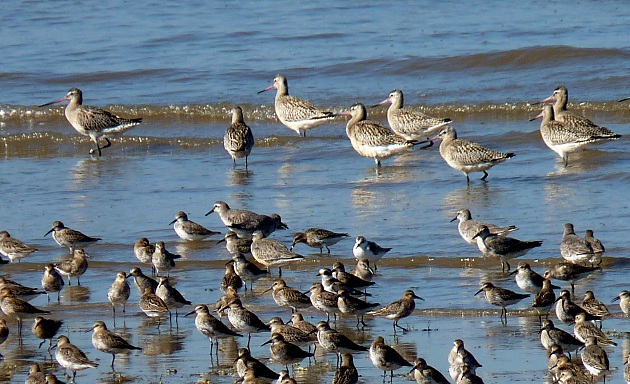
Top of Page
Point of Ayr RSPB Reserve - Voluntary Wardens Wanted!
Point of Ayr, on the North Wales coast at Talacre, is a great place to watch a variety of birds as they come in to roost at high tide, but unfortunately the site is extremely vulnerable to human disturbance. The RSPB is looking for extra volunteers to help warden this invaluable roost site, and protect the birds throughout the cold winter months.
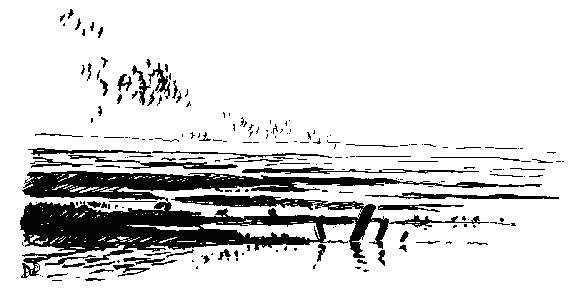
Shifts are run most weekends and typically last between 3-4 hours,
depending on the height of the tide.
If you would like to help in any way please contact the RSPB on 0151
353 8478 or Mobile 07860169452 . Not only
are you helping to save the planet, but it’s also great birdwatching
too!
Top of Page
August Bird News
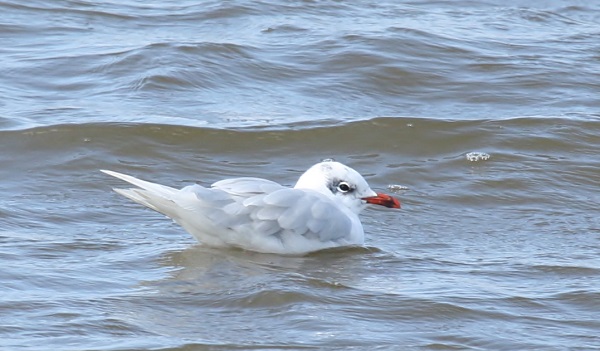
austinmorley.blogspot.co.uk
The Gronant Little Tern colony produced at least 60 fledged young, a relatively poor year mainly due to that gale in June coinciding with a very high tide which washed many nests away.
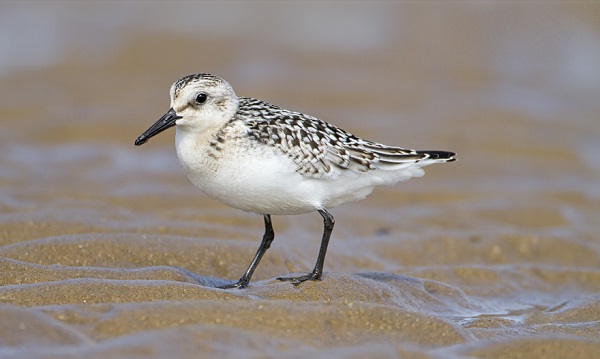
Good numbers of waders included two rarities- a Pectoral Sandpiper and Temminck's Stint at Burton Mere Wetlands. A handful of juvenile Curlew Sandpiper records hinted of a possible good passage of them in September. There were lots of small waders roosting at high tide at Hoylake Shore including a count of 1,600 Ringed Plover, which I reckon is the highest count on the Dee estuary area since the 1970s! Up to 1,000 Black-tailed Godwits were off Heswall, Thurstaston and West Kirby through the month, a very high number here for August when they are normally inland or on the Welsh side of the estuary. Over 10 Spotted Reshank were at the Connah's Quay Reserve.
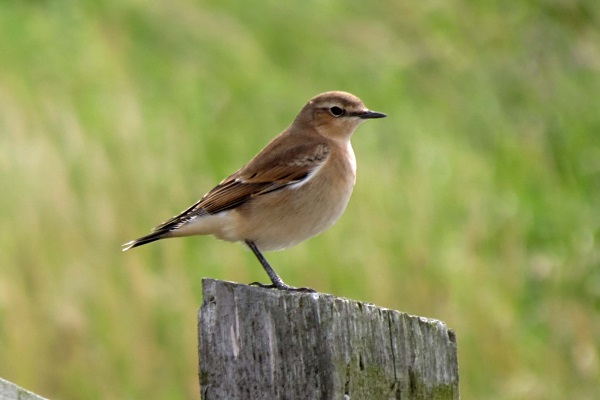
There was a small pasage of Wheatears observed on Hilbre and along north Wirral. At least two Marsh Harriers and a ringtail Hen Harrier have been records on the marshes and at Burton Mere Wetlands. Six Goosanders were at Hilbre on the 27th, and they are becoming almost a regular visitor in August in recent years.
Richard Smith.
What to expect in September
Then some years September can be windless, but all need not be lost. There should be plenty of waders to see and we particularly look forward to seeing Curlew Sandpipers. 2011 was the last major influx of these - see the November 2011 Newsletter for details. We often get good numbers of Little Stints and Ruff as well, and a good chance of something much rarer. Other waders should include Greenshanks on passage, best seen at Burton Mere Wetlands, Parkgate and the Connah's Quay Reserve.
On the marshes may well be a Great White Egret or two plus a Spoonbill, and both Hen and Marsh Harriers; any Ospreys will likely be passing over quickly so you will be lucky if you spot one. Apart from the sea birds mentioned above, in less windy conditions there should still be plenty of terns around early in the month, and we can get a large build up of gulls including Mediterranean and, perhaps, much rarer gull species.
Top of Page
Forthcoming Events
September Highest Spring Tides (Liverpool)
Also
see Tides
page.
19th September, 11.45hrs (BST), 9.5m.
20th September, 12.24hrs (BST), 9.6m.
21st September, 13.02hrs (BST), 9.5m.
Forthcoming Events
Organised by the Wirral
Ranger Service , Flintshire Countryside Service and/or the
RSPB:
All these events and walks have bird interest, even those not
advertised specifically for birdwatching. No need to book for these
events unless specified - please check below.
Also see 2013 Events Diary.
6.30PM start.
Price: Adults £5 (£3 for RSPB members); Children £1 (free for Wildlife Explorer members)
Booking essential
The Dee Estuary is home to the largest number of little egrets in the entire North of England and believe it or not they all roost in one small woodland beside Burton Mere Wetlands.
Come along for this exciting evening walk to discover this daily spectacle in all its glory and learn about the Little Egret's troubled past and current success. The walk will also get you close to some of the bats that make their home on the reserve, and there's even a chance you'll see one of our resident badgers!
This is an exclusive chance to have one of our wardens show you the nocturnal wildlife that lives here but which is rarely seen!
Places are limited so book in advance to avoid disappointment.
Ring 0151 353 8478.
Saturday 7th September 9:30am – 4:30pm
The Big Seawatch
Join the Coastal Rangers, staff from the RSPB and Hilbre Bird Observatory for a day on Hilbre looking for seabirds and wading birds that inhabit our wonderful coast. We will be staying on Hilbre during high tide giving us the best chance to see them with experts on hand! Places are limited with a suggested donation of £5:00 for this event which includes tea/coffee. To book your place please ring (0151) 648 4371.
Saturday 14th September 9:00am – 2:00pm
Hilbre Birdwatch:
Join the Coastal Rangers and RSPB on this low water walk across the sands to Hilbre Islands to enjoy the island’s birds and wildlife. Suitable clothing, stout footwear or wellingtons are recommended. Bring binoculars if you have them. Places are limited and a suggested donation of £3:00 will be gratefully received for this event.
Booking is essential (0151) 648 4371.
Saturday 21st September, 11:00am start, High Tide Birdwatch at Hoylake:
You will discover why Wirral’s foreshore is an internationally protected site when you join the Dee Estuary Voluntary Wardens, Coastal Rangers and the RSPB on this high tide birdwatch at Hoylake. Dress warmly and bring binoculars if you have them. No need to book.
Meet at the bottom of Trinity Road, King’s Parade, Hoylake. High tide just before 1pm, 9.5m.
For further information please ring (0151) 648 4371.
Saturday 5th October, 10am to 3pm, Connah's Quay Nature Reserve Open Day.
High tide 9.4m at 11.59am.
An opportunity to visit this great reserve normally open to members only - should be large numbers of waders and duck roosting at high tide.
How to find us: From A548 take the Connah’s Quay turn off and follow the Power Station signs. At the reserve entrance, (Grid ref SJ271 714) you will be met by a member of the Society.
Tea and coffee available at the Field Studies Centre.
FREE ADMISSION
